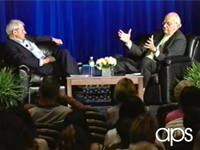Testifying in Court Can Amplify Trauma For Victims of Childhood Sexual Abuse
It goes without saying that childhood sexual abuse is often a traumatic experience. Add to that revisiting the abuse in courtroom testimony, and a complex picture emerges about the full impact the abuse can have on a victim.
In her invited address at the APS 18th Annual Convention, “Childhood Trauma, and Court: The Psychology and the Law,” Gail Goodman, University of California, Davis, discussed research findings on the after-effects of childhood sexual abuse (CSA), highlighting the potentially damaging effects of a related event that is all too often overlooked: the trauma of testifying about CSA during trial.
Between 1986 and 1988, Goodman and her team of researchers studied the behavioral patterns of over 200 children involved as victims in CSA prosecutions. They re-interviewed 174 of the victims as young adults (between 1997 and 2001), looking at their memories of the abuse and their current pathology and searching for correlations between their state as young children at the time of the CSA prosecutions and their later mental health.
“The picture is really complex, and you have to understand the circumstances surrounding the child and the case to make a prediction,” said Goodman. Certain conditions, such as whether the child had to testify multiple times throughout a prosecution, was the strongest predictor of later traumatization. Other, less stable predictors include gender, age at the time of testimony, and the length of the perpetrator’s sentence.
In children who testified multiple times, especially if the abuse was severe and intrafamilial, Goodman’s team found correlations with later sexual problems, defensive avoidance, and internalization problems, such as depression. Even “children who in the 1980s seemed more resilient, if they testified more than once, later as adults did nearly as badly as those who presented behavioral problems” at the time of testimony, Goodman said. Children who were already deeply disturbed at the time of the testimony fared worst of all: “If the child is already crying at that point, that’s a bad sign for later on.”
Despite these troublesome findings, Goodman does not believe that keeping young children from testifying is always the right solution. “In terms of attitudes, it may be important for the child to testify,” she said. CSA victims who had the chance to speak at trial tend to have a more positive attitude towards the legal system and are more likely to think that the trial of their abuser was fair, she explained.
Part of Goodman’s study focused on memory in conjunction with research on post-traumatic stress disorder (PTSD), and Goodman’s team found many connections between the two. Delayed disclosure of CSA is common, so knowing how well people remember is important in considering whether they should testify about events that occurred. Goodman asked the adults what they remembered about the CSA and also what was the most traumatic event of their lives. Based on comparisons between what they reported as young children and what they said when later interviewed, adults with PTSD who were victimized had clear memories of the abuse whether or not the PTSD was caused by CSA. Those with few symptoms of PTSD who remembered something else, like a car accident, as their most traumatic life event had the least accurate memories. She proposed that poor memory is associated with defensive avoidance: that individuals who suppress their feelings about the trauma, don’t want to think about the past, and don’t show signs of PTSD are more likely to have faded memories than those who are more overtly traumatized. Overall, the best predictor for correct memory was the level of abuse. “The worse it is, the more traumatizing, the better the memory,” she said. However, for avoidant individuals, this was not necessarily so.
Throughout her presentation, Goodman emphasized that although predictors exist, there are variations among individuals that must be considered in each case. Regardless of this caveat, audience members were intrigued. Chuck Mueller, a child clinical psychologist from the University of Hawaii at Manoa, said, “It’s very interesting, very provocative…. I was thinking about how much we want to incorporate this topic.”
National Institute of Child Health and Human Development researchers Mel Pipe and Yael Orbach expressed their admiration for Goodman’s care in taking so many factors into account. “She, in many ways, started the field,” said Pipe. “It really is a great example of science being applied.”




Comments
Is there any way I could have the links to the study that this article is referring to?
APS regularly opens certain online articles for discussion on our website. Effective February 2021, you must be a logged-in APS member to post comments. By posting a comment, you agree to our Community Guidelines and the display of your profile information, including your name and affiliation. Any opinions, findings, conclusions, or recommendations present in article comments are those of the writers and do not necessarily reflect the views of APS or the article’s author. For more information, please see our Community Guidelines.
Please login with your APS account to comment.